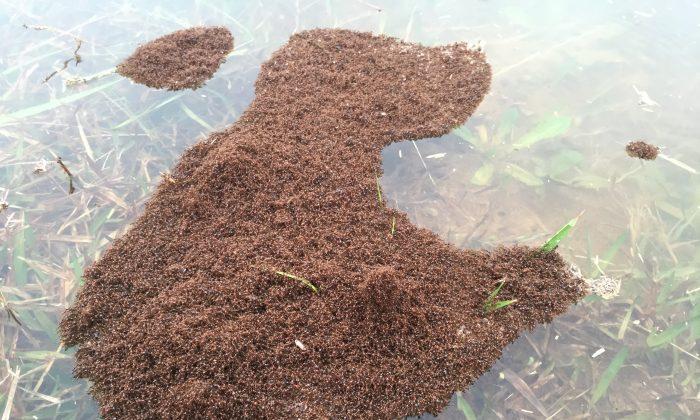If flooded homes and roaming alligators were not enough for Houston residents to worry about, rafts of fire ant colonies have been seen floating down Houston’s flooded streets.
Despite living most of their lives in the ground, fire ants are surprisingly well-adapted to floods; having evolved in the Pantanal wetlands of Brazil, an environment that experiences periodic flooding.
An entire colony of fire ants can up and go in about 100 seconds. The colonies, which can number thousands to millions of individual ants, are able to form floating mats by linking their limbs together. This is possible due to the sticky pads on the ends of their limbs.
Once the ants are linked, they form into a water-repellent pancake. According to a 2011 study, the rough texture of an ant’s hard external skeleton helps to trap air bubbles next to the ant’s body when it meets water. In this way, the whole colony is able to float on the water’s surface.
The most important members of the colony—the queen, larvae, and eggs—are protected by staying in the middle of the floating island.
“They use the wax together on their bodies to keep the queen and other members of the colony in the middle of the ball dry so they don’t suffocate,” Mike Merchant, entomology specialist at the Texas A&M AgriLife Extension Service, told Wired.
Merchant explained that submerged worker ants are always rotating with workers ants from above the waterline. In this way, the island of floating ants can survive for months in their shifting raft formation.
Using this survival tactic, the colony is able to survive floods. But once the ants hit something dry—anything dry—they will attempt to board, often working to form a tower-like structure which provides some protection from rain before their new mound is established.
Residents who encounter these floating ant islands are urged not to make contact. Once the ants have made contact, they are almost impossible to remove, according to Texas A&M Agrilife Extension.
“If you are in a row boat, do not touch the ants with the oars since they can ‘climb aboard’ via the oars,” their guidelines state.
If you are boarded by a fire ant colony, quickly find some dishwashing liquid. This may be the only thing that can help you wash the ants off. Spraying a floating ant island with detergent, preferably a biodegradable type, can drown the ants.
Texas A&M Agrilife Extension recommends, “Dress appropriately when working in floodwater. Cuffed gloves, rain gear, and rubber boots help prevent the ants from reaching the skin. If they do, they will bite and sting. Remove them immediately by rubbing them off. If submerged, ants will cling to the skin and even a high-pressure water spray may not dislodge them.”
Fire ants can leave a painful sting. One ant can bite multiple times, and the venom in the sting can leave painful white pustules on the victim.
Although fire ant venom is not life-threatening, some people may experience an allergic reaction. It is not uncommon for victims who have many bites to experience anaphylactic shock.
“Nausea, shortness of breath, or unusual swelling of the sting area are symptoms that should prompt immediate medical attention,” recommends Texas A&M Agrilife Extension.
Over-the-counter medicines for insect bites or stings may help treat discomfort from ant bites. Other options for treatment that you may have around the house include dabbing diluted ammonia, camphor, meat tenderizer (papain), or tea tree oil on the affected areas.
Therefore, residents are advised to use care during the flood cleanup and look out for fire ant colonies that might have settled in new areas, such as piles of debris or inside flooded homes.
During floods, fire ants can expand their territory as the raft colonies float to areas not previously colonized by the creatures.
Fire ants were unintentionally transported around the world during the 16th century in the ballast soil used to stabilize Spanish naval ships, according to Live Science. As a resilient, aggressive, and fast reproducing species, fire ants are now found in most tropical climates worldwide. They arrived in the United States in the 1930s, and Texas in the 1950s.
Wherever they appear, fire ants are infamous for causing destruction to crops and impacting the distribution of native species. “Controlling them costs millions of dollars annually,” says Sara Helms Cahan, a biologist at the University of Vermont.






Friends Read Free